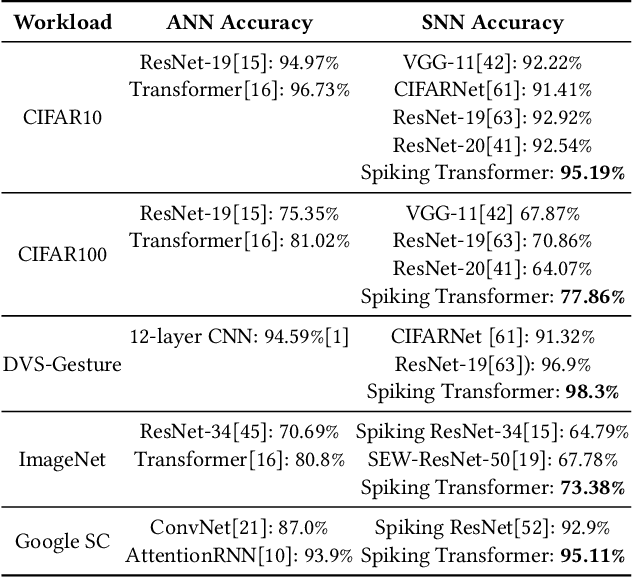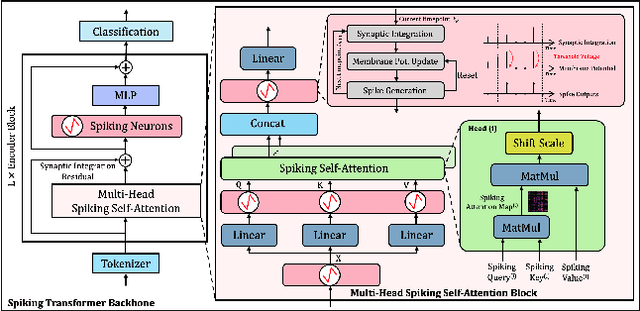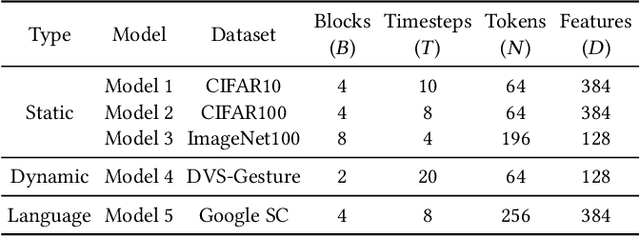Boxun Xu
Khan-GCL: Kolmogorov-Arnold Network Based Graph Contrastive Learning with Hard Negatives
May 21, 2025Abstract:Graph contrastive learning (GCL) has demonstrated great promise for learning generalizable graph representations from unlabeled data. However, conventional GCL approaches face two critical limitations: (1) the restricted expressive capacity of multilayer perceptron (MLP) based encoders, and (2) suboptimal negative samples that either from random augmentations-failing to provide effective 'hard negatives'-or generated hard negatives without addressing the semantic distinctions crucial for discriminating graph data. To this end, we propose Khan-GCL, a novel framework that integrates the Kolmogorov-Arnold Network (KAN) into the GCL encoder architecture, substantially enhancing its representational capacity. Furthermore, we exploit the rich information embedded within KAN coefficient parameters to develop two novel critical feature identification techniques that enable the generation of semantically meaningful hard negative samples for each graph representation. These strategically constructed hard negatives guide the encoder to learn more discriminative features by emphasizing critical semantic differences between graphs. Extensive experiments demonstrate that our approach achieves state-of-the-art performance compared to existing GCL methods across a variety of datasets and tasks.
SpikeX: Exploring Accelerator Architecture and Network-Hardware Co-Optimization for Sparse Spiking Neural Networks
May 18, 2025Abstract:Spiking Neural Networks (SNNs) are promising biologically plausible models of computation which utilize a spiking binary activation function similar to that of biological neurons. SNNs are well positioned to process spatiotemporal data, and are advantageous in ultra-low power and real-time processing. Despite a large body of work on conventional artificial neural network accelerators, much less attention has been given to efficient SNN hardware accelerator design. In particular, SNNs exhibit inherent unstructured spatial and temporal firing sparsity, an opportunity yet to be fully explored for great hardware processing efficiency. In this work, we propose a novel systolic-array SNN accelerator architecture, called SpikeX, to take on the challenges and opportunities stemming from unstructured sparsity while taking into account the unique characteristics of spike-based computation. By developing an efficient dataflow targeting expensive multi-bit weight data movements, SpikeX reduces memory access and increases data sharing and hardware utilization for computations spanning across both time and space, thereby significantly improving energy efficiency and inference latency. Furthermore, recognizing the importance of SNN network and hardware co-design, we develop a co-optimization methodology facilitating not only hardware-aware SNN training but also hardware accelerator architecture search, allowing joint network weight parameter optimization and accelerator architectural reconfiguration. This end-to-end network/accelerator co-design approach offers a significant reduction of 15.1x-150.87x in energy-delay-product(EDP) without comprising model accuracy.
Bishop: Sparsified Bundling Spiking Transformers on Heterogeneous Cores with Error-Constrained Pruning
May 18, 2025



Abstract:We present Bishop, the first dedicated hardware accelerator architecture and HW/SW co-design framework for spiking transformers that optimally represents, manages, and processes spike-based workloads while exploring spatiotemporal sparsity and data reuse. Specifically, we introduce the concept of Token-Time Bundle (TTB), a container that bundles spiking data of a set of tokens over multiple time points. Our heterogeneous accelerator architecture Bishop concurrently processes workload packed in TTBs and explores intra- and inter-bundle multiple-bit weight reuse to significantly reduce memory access. Bishop utilizes a stratifier, a dense core array, and a sparse core array to process MLP blocks and projection layers. The stratifier routes high-density spiking activation workload to the dense core and low-density counterpart to the sparse core, ensuring optimized processing tailored to the given spatiotemporal sparsity level. To further reduce data access and computation, we introduce a novel Bundle Sparsity-Aware (BSA) training pipeline that enhances not only the overall but also structured TTB-level firing sparsity. Moreover, the processing efficiency of self-attention layers is boosted by the proposed Error-Constrained TTB Pruning (ECP), which trims activities in spiking queries, keys, and values both before and after the computation of spiking attention maps with a well-defined error bound. Finally, we design a reconfigurable TTB spiking attention core to efficiently compute spiking attention maps by executing highly simplified "AND" and "Accumulate" operations. On average, Bishop achieves a 5.91x speedup and 6.11x improvement in energy efficiency over previous SNN accelerators, while delivering higher accuracy across multiple datasets.
Trimming Down Large Spiking Vision Transformers via Heterogeneous Quantization Search
Dec 07, 2024



Abstract:Spiking Neural Networks (SNNs) are amenable to deployment on edge devices and neuromorphic hardware due to their lower dissipation. Recently, SNN-based transformers have garnered significant interest, incorporating attention mechanisms akin to their counterparts in Artificial Neural Networks (ANNs) while demonstrating excellent performance. However, deploying large spiking transformer models on resource-constrained edge devices such as mobile phones, still poses significant challenges resulted from the high computational demands of large uncompressed high-precision models. In this work, we introduce a novel heterogeneous quantization method for compressing spiking transformers through layer-wise quantization. Our approach optimizes the quantization of each layer using one of two distinct quantization schemes, i.e., uniform or power-of-two quantification, with mixed bit resolutions. Our heterogeneous quantization demonstrates the feasibility of maintaining high performance for spiking transformers while utilizing an average effective resolution of 3.14-3.67 bits with less than a 1% accuracy drop on DVS Gesture and CIFAR10-DVS datasets. It attains a model compression rate of 8.71x-10.19x for standard floating-point spiking transformers. Moreover, the proposed approach achieves a significant energy reduction of 5.69x, 8.72x, and 10.2x while maintaining high accuracy levels of 85.3%, 97.57%, and 80.4% on N-Caltech101, DVS-Gesture, and CIFAR10-DVS datasets, respectively.
Towards 3D Acceleration for low-power Mixture-of-Experts and Multi-Head Attention Spiking Transformers
Dec 07, 2024Abstract:Spiking Neural Networks(SNNs) provide a brain-inspired and event-driven mechanism that is believed to be critical to unlock energy-efficient deep learning. The mixture-of-experts approach mirrors the parallel distributed processing of nervous systems, introducing conditional computation policies and expanding model capacity without scaling up the number of computational operations. Additionally, spiking mixture-of-experts self-attention mechanisms enhance representation capacity, effectively capturing diverse patterns of entities and dependencies between visual or linguistic tokens. However, there is currently a lack of hardware support for highly parallel distributed processing needed by spiking transformers, which embody a brain-inspired computation. This paper introduces the first 3D hardware architecture and design methodology for Mixture-of-Experts and Multi-Head Attention spiking transformers. By leveraging 3D integration with memory-on-logic and logic-on-logic stacking, we explore such brain-inspired accelerators with spatially stackable circuitry, demonstrating significant optimization of energy efficiency and latency compared to conventional 2D CMOS integration.
Spiking Transformer Hardware Accelerators in 3D Integration
Nov 11, 2024Abstract:Spiking neural networks (SNNs) are powerful models of spatiotemporal computation and are well suited for deployment on resource-constrained edge devices and neuromorphic hardware due to their low power consumption. Leveraging attention mechanisms similar to those found in their artificial neural network counterparts, recently emerged spiking transformers have showcased promising performance and efficiency by capitalizing on the binary nature of spiking operations. Recognizing the current lack of dedicated hardware support for spiking transformers, this paper presents the first work on 3D spiking transformer hardware architecture and design methodology. We present an architecture and physical design co-optimization approach tailored specifically for spiking transformers. Through memory-on-logic and logic-on-logic stacking enabled by 3D integration, we demonstrate significant energy and delay improvements compared to conventional 2D CMOS integration.
ADO-LLM: Analog Design Bayesian Optimization with In-Context Learning of Large Language Models
Jun 26, 2024Abstract:Analog circuit design requires substantial human expertise and involvement, which is a significant roadblock to design productivity. Bayesian Optimization (BO), a popular machine learning based optimization strategy, has been leveraged to automate analog design given its applicability across various circuit topologies and technologies. Traditional BO methods employ black box Gaussian Process surrogate models and optimized labeled data queries to find optimization solutions by trading off between exploration and exploitation. However, the search for the optimal design solution in BO can be expensive from both a computational and data usage point of view, particularly for high dimensional optimization problems. This paper presents ADO-LLM, the first work integrating large language models (LLMs) with Bayesian Optimization for analog design optimization. ADO-LLM leverages the LLM's ability to infuse domain knowledge to rapidly generate viable design points to remedy BO's inefficiency in finding high value design areas specifically under the limited design space coverage of the BO's probabilistic surrogate model. In the meantime, sampling of design points evaluated in the iterative BO process provides quality demonstrations for the LLM to generate high quality design points while leveraging infused broad design knowledge. Furthermore, the diversity brought by BO's exploration enriches the contextual understanding of the LLM and allows it to more broadly search in the design space and prevent repetitive and redundant suggestions. We evaluate the proposed framework on two different types of analog circuits and demonstrate notable improvements in design efficiency and effectiveness.
DISTA: Denoising Spiking Transformer with intrinsic plasticity and spatiotemporal attention
Nov 15, 2023Abstract:Among the array of neural network architectures, the Vision Transformer (ViT) stands out as a prominent choice, acclaimed for its exceptional expressiveness and consistent high performance in various vision applications. Recently, the emerging Spiking ViT approach has endeavored to harness spiking neurons, paving the way for a more brain-inspired transformer architecture that thrives in ultra-low power operations on dedicated neuromorphic hardware. Nevertheless, this approach remains confined to spatial self-attention and doesn't fully unlock the potential of spiking neural networks. We introduce DISTA, a Denoising Spiking Transformer with Intrinsic Plasticity and SpatioTemporal Attention, designed to maximize the spatiotemporal computational prowess of spiking neurons, particularly for vision applications. DISTA explores two types of spatiotemporal attentions: intrinsic neuron-level attention and network-level attention with explicit memory. Additionally, DISTA incorporates an efficient nonlinear denoising mechanism to quell the noise inherent in computed spatiotemporal attention maps, thereby resulting in further performance gains. Our DISTA transformer undergoes joint training involving synaptic plasticity (i.e., weight tuning) and intrinsic plasticity (i.e., membrane time constant tuning) and delivers state-of-the-art performances across several static image and dynamic neuromorphic datasets. With only 6 time steps, DISTA achieves remarkable top-1 accuracy on CIFAR10 (96.26%) and CIFAR100 (79.15%), as well as 79.1% on CIFAR10-DVS using 10 time steps.
UPAR: A Kantian-Inspired Prompting Framework for Enhancing Large Language Model Capabilities
Sep 30, 2023Abstract:Large Language Models (LLMs) have demonstrated impressive inferential capabilities, with numerous research endeavors devoted to enhancing this capacity through prompting. Despite these efforts, a unified epistemological foundation is still conspicuously absent. Drawing inspiration from Kant's a priori philosophy, we propose the UPAR prompting framework, designed to emulate the structure of human cognition within LLMs. The UPAR framework is delineated into four phases: "Understand", "Plan", "Act", and "Reflect", enabling the extraction of structured information from complex contexts, prior planning of solutions, execution according to plan, and self-reflection. This structure significantly augments the explainability and accuracy of LLM inference, producing a human-understandable and inspectable inferential trajectory. Furthermore, our work offers an epistemological foundation for existing prompting techniques, allowing for a possible systematic integration of these methods. With GPT-4, our approach elevates the accuracy from COT baseline of 22.92% to 58.33% in a challenging subset of GSM8K, and from 67.91% to 75.40% in the causal judgment task.
 Add to Chrome
Add to Chrome Add to Firefox
Add to Firefox Add to Edge
Add to Edge